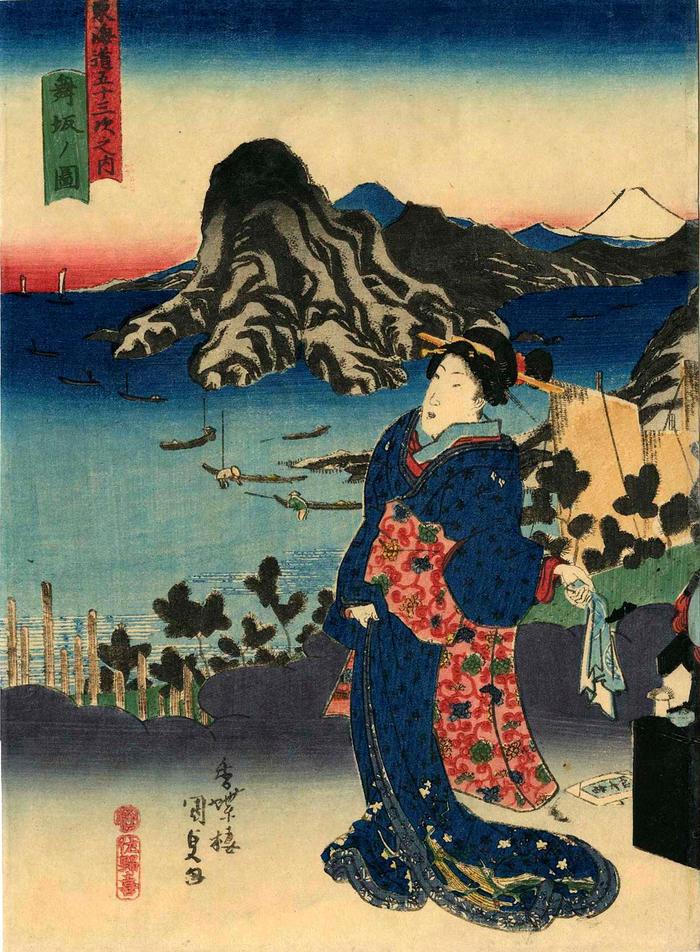Utagawa Kunisada (歌川国貞) / Toyokuni III (三代豊国) (artist 1786 – 01/12/1865)
View of Maisaka (Maisaka no zu: 舞阪ノ図) from the series Fifty-three Stations of the Tōkaidō Road (Tōkaidō gojūsan tsugi no uchi: 東海道五十三次之内)
ca 1838
7 in x 9.75 in (Overall dimensions) Japanese woodblock print
Signed: Kōchōrō Kunisada ga (香蝶楼国貞画)
Publisher: Sanoya Kihei
Censor's seal: kiwame
Museum of Fine Arts, Boston
National Diet Library
Spencer Museum of Art
British Museum - Hiroshige's 'Maisaka Imagire shinkei' version
Museum für angewandte Kunst, Vienna
Ishikawa Prefectural Museum of Art - they date their copy to 1836
Bryn Mawr
Honolulu Museum of Art - ca. 1830-35
Musée d’art et d’histoire, Ville de Genève
Honolulu Museum of Art - 1848
Fujisawa Ukiyo-e Museum
Victoria and Albert Museum
Nelson-Atkins Museum of Art This view is seen from above the Imagiri (New Break) highlands. It can also be spelled 'Imagire'. The high peak across the water does not exist in reality, but was created wholly out of the imagination of Hiroshige. Kunisada in this print followed Hiroshige's lead.
****
This is print number 31 in this series. The curatorial files at the Museum für angewandte Kunst in Vienna say: "Except for a few details, the landscape depiction is similar to Hiroshige's original. In the foreground a woman at the toilet. She is holding a towel in her hand (tenugui 手 拭). Next to her is a mirror table on which there is a can and a brush for applying powder. On the floor there is a paper envelope with the inscription".
Kunisada's chūban Bijin Tokaido (東海道美人) series was first published around 1833, after Hiroshige's famous series was underway but not yet complete.
****
Several of the printings show more along the right edge. We noticed this because in some of the cases the mirror was more prominently displayed, but still only partially.
The packet lying on the ground near the mirrorstand says 'Senjoko' (仙女香) which is probably short for 'Bien Senjoko' [美艶仙女香], a firm which sold a popular white face powder. This might mean that this particular printing could have been underwritten by this particular cosmetics firm. Another such packet appears in another print by Kunisada - Lyon Collection #753.
****
Sebastian Izzard noted, in speaking of a different series, that one of the prints in this set displays "...a packet of Bien Senjokō (Beautiful fairly maiden fragrance), a popular cosmetic whose brand name was based on the poetry name (haimyō) Rokō, of the Kabuki actor Segawa Kikunojō V (1802-32), one of Edo's leading contemporary onnagata, or players of female roles. It was manufactured by Sakemoto, a man who often used beauty and landscape prints to promote his products. Indeed, selling this kind of advertising was a common way for publishers, such as Azumaya to defray the expenses of producing prints."
****
In Tokaido Landscapes: The Path from Hiroshige to Contemporary Artists, 2011, #31, p. 43, speaking of the original Hiroshige print it says in a text by Sasaki Moritoshi: "In the past, Lake Hamana was not connected to the sea, but a large earthquake in 1498 broke through the narrow strip of land that had separated the two bodies of water. [Some say it was in 1499.] The channel thus created was called Imagire ("just broken"). This made necessary the Imagire crossing from Maisaka on the east to Arai on the west. Hiroshige drew a pastoral scene of the small boats in the lake that were used to catch eels, a specialty of the area. The scene in the drawing is not an actual view of Imagire, but he viewer's eye is drawn along the breakwater posts in the foreground, to the large yellow sails, then to the eel boats and on the mountains in the distance, so the scene does not seem unnatural at all."
****
In Hiroshige: l'art du voyage, Paris, 2012, p. 80 they identify the boats with the sails as being bezaibune (ベザイ船), vessels which revolutionized sailing sometime around 1750 because of the use of large sails reducing the need to man the ship with numerous oarsmen.
****
Muneshige Narazaki in Masterworks of Ukiyo-e: Hiroshige, the 53 Stations of the Tōkaidō (p. 62) noted: "It is at Maisaka that we finally reach the sea. Originally there was a strip of land - it is mentioned in the Sarashina Diary - between Lake Hamana and the open ocean, but the great tidal wave of 1499 washed the land bridge away. The mountains are not actually so rugged as Hiroshige has depicted them. In the far distance, on the right, is a glimpse of Mount Fuji, covered with snow."
****
Illustrated in a small color reproduction in Kunisada's Tokaido: Riddles in Japanese Woodblock Prints by Andreas Marks, Hotei Publishing, 2013, page 70, T24-31.
Sanoya Kihei (佐野屋喜兵衛) (publisher)
landscape prints (fūkeiga 風景画) (genre)
beautiful woman picture (bijin-ga - 美人画) (author)
